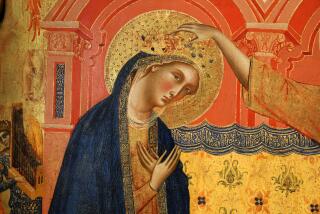Mostly Stray Cats, Tourists in Rome : Europe Getting Ready to Doze in the Sun
- Share via
ROME — Figures that shimmer in the Roman heat: an athletic Pope, swaying fashion models, a hedonist politician, prancing designers, moonlit sopranos, and a dead bugler, late of the 7th U.S. Cavalry. It is summertime in the Mediterranean.
Mountain-climbing John Paul II reluctantly returned to the Vatican on Friday with an aching entourage as tens of thousands of Romans fled the city in an annual Mediterranean migration of city dwellers to the sea.
From Turkey to France, from Tunisia to Greece, the working life of big cities is all but coming to a halt. By this time next week, and until after Sept. 1, the sun in Rome will shine mostly on tourists and stray cats, with only a handful of Romans to watch over them from behind thick wooden shutters.
The Pope came back in fine fettle from a 9-day vacation in the Alps near the Austrian border, climaxed by a scramble up a peak of nearly 9,000 feet. After crossing a glacier, the Pope turned to his local guide, pointed at the summit and asked: “Does anyone get there?”
“Only young people, Holiness,” the guide replied, “not those who have been closed inside the Vatican for 10 years.
Replied With a Twinkle
To this the 68-year-old Pope replied with a twinkle, by later account of one of the bone-weary survivors: “We are all young here. The average age should be around 52.” And he went on to the top, dragging behind him a breathless but prideful pack of Vatican bureaucrats.
The Pope will remain in the Vatican only a few days before journeying to Castel Gandolfo south of the city, the lakeside palace that has been the summer residence of popes for 350 years.
Other noted Romans are on the move as well. Foremost among them seems to be three-chinned, Falstaff-shaped Gianni De Michelis, deputy prime minister of Italy. In sober government circles he is known as Your Excellency, but among some admirers with whom he dances until dawn, De Michelis, a 47-year-old Socialist, is known affectionately as Sua Frivolezza --Your Frivolity.
“Where Are We Going to Dance Tonight?” De Michelis’ closely researched study of the 250 best discotheques in Italy (chosen from 7,000 candidates), was published this month and is on its way to the best-seller list.
“When I decided to do the book, a year ago it never occurred to me I’d be deputy prime minister,” De Michelis said. “It has been torture reconciling my government work with research for the book. What a job! Thank goodness I had six women helping me.”
Roman socialite Marina Ripa di Meana, a sometime De Michelis disco partner, told the magazine Panorama that the deputy prime minister was light on his feet for a fat man but that he danced with “childlike enthusiasm”--more verve than style.
One of De Michelis’ favorite discos is the Paradiso Club, situated in the Adriatic resort city of Rimini. But even for those trapped in Rome, the music seldom stops these summer nights, and it is hardly ever necessary to stay inside to hear it.
There is chamber and orchestra music under the stars in Michelangelo’s square before the City Hall and near the Piazza Navona. There is operetta in the Botanical Gardens, grand opera in the ruins of the Roman baths at Caracalla, and open air jazz across the Tiber in Trastevere.
In modern-day Rome, cinema has supplanted chariot racing at the Circus Maximus. The other night, thousands massed in the playground of the Roman emperors to see Bernardo Bertolucci’s Oscar-winning epic about the last Chinese emperor. That same night, Romans of a more futurist bent watched next season’s fashions paraded at an outdoor fashion show at the Piazza di Spagna. Nightly, designers and buyers vie with tourists for outdoor tables at restaurants where waiters count the days until the annual August closing.
No account remains of Giovanni Martini’s musical prowess, but he was remembered just the same this week on the 140th anniversary of his birth by Italian fans of the American Wild West.
Born in a cow pasture that later excavations would transform into the Roman Forum, Martini was a drummer boy in the army of Giuseppe Garibaldi, who unified Italy in the 1860s. Later, he took his taste for music and the military life to America.
As John Martin, he went west, and on June 26, 1876, Trooper Martin rode into the Little Big Horn as bugler for Gen. George Armstrong Custer. Realizing the danger, Custer’s staff sent Martin galloping for reinforcements. The Sioux at his heels, he delivered his message to another column of 7th Cavalry troops, but when he returned with them it was too late. The ghost of Giovanni Martini, the only survivor of Custer’s Last Stand, is one of the figures shimmering in the heat and history of this Roman summer.
More to Read
Sign up for The Wild
We’ll help you find the best places to hike, bike and run, as well as the perfect silent spots for meditation and yoga.
You may occasionally receive promotional content from the Los Angeles Times.






